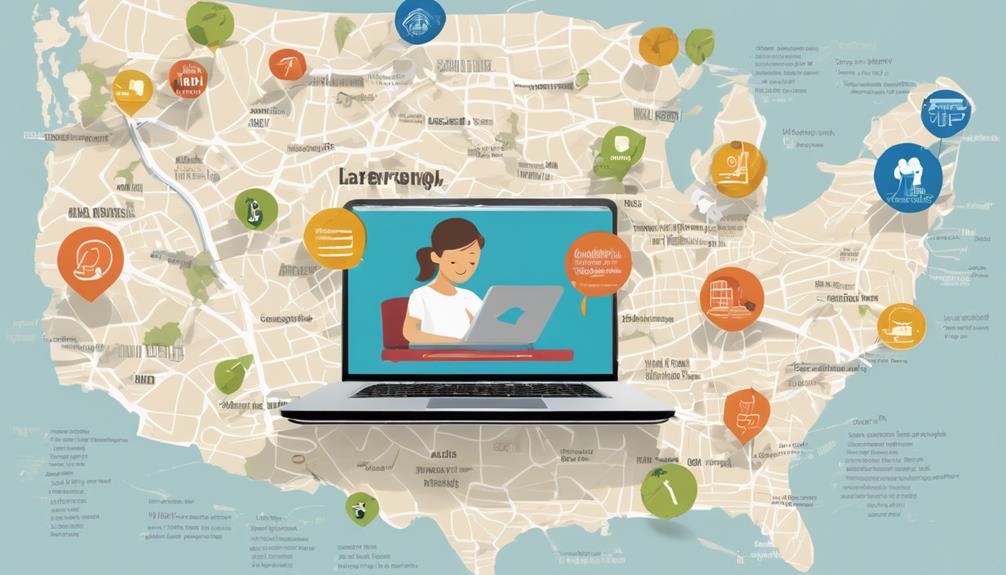Virtual reality exposure can be a highly effective way to help deaf teens manage social anxiety. It creates a safe, controlled environment where you can practice social interactions with sign language support, reducing frustration from communication barriers. The VR experience can be customized to match your sensory needs, preventing overload and gradually building confidence. If you want to learn how this innovative approach can help you navigate social situations more comfortably, there’s more to discover.
Key Takeaways
- VR therapy with sign language reduces communication barriers, making social exposure comfortable and accessible for deaf teens.
- Customized sensory settings prevent overload and allow gradual exposure to social stimuli, easing anxiety.
- Repeated virtual social scenarios help build confidence and develop social skills in a safe environment.
- Incorporating sign language ensures natural interactions, reducing frustration and enhancing understanding during therapy.
- Secure, personalized VR experiences support deaf teens in overcoming social anxiety at their own pace.

Social anxiety can profoundly impact deaf teens, making everyday interactions feel overwhelming. When faced with social situations, you might find yourself avoiding gatherings or feeling intense nervousness even in familiar environments. Virtual reality (VR) offers a promising way to help you gradually confront and manage these fears. One key aspect of effective VR therapy is sign language integration. By incorporating sign language into the virtual environment, you can communicate naturally and comfortably, reducing the frustration that often accompanies language barriers. This approach guarantees that you feel understood and supported throughout the process, making the exposure more realistic and less intimidating. Sign language integration in VR creates a familiar, accessible experience, helping you build confidence as you navigate social scenarios.
Another essential component of VR therapy for deaf teens is sensory adaptation. Virtual environments can be tailored to match your sensory needs, whether you’re sensitive to certain sounds, visual stimuli, or tactile feedback. Sensory adaptation allows the virtual experience to be gradually adjusted to your comfort level, preventing sensory overload and making the exposure less overwhelming. For example, if loud noises trigger anxiety, the VR system can reduce or eliminate auditory stimuli, focusing instead on visual cues and sign language communication. As you become more comfortable, the virtual environment can slowly introduce more complex stimuli, helping you develop coping strategies in a controlled, safe space. This gradual approach enables you to build resilience without feeling overwhelmed. Additionally, incorporating AI security ensures that your personal data and sensitive information remain protected throughout your therapy sessions, maintaining your privacy and trust.
The integration of sign language and sensory adaptation in VR creates a personalized, immersive experience that aligns with your unique needs. It allows you to practice social interactions in a safe setting, where mistakes are part of the learning process and not judged. Through repeated exposure, you can learn to manage anxiety triggers and develop new social skills, all within a supportive virtual environment. This method also offers the flexibility to practice in various scenarios—like school settings, social gatherings, or public spaces—without the pressure of real-world consequences. Over time, these controlled exposures can translate into increased confidence and reduced anxiety during actual social interactions.
Ultimately, VR therapy with sign language integration and sensory adaptation provides a tailored, accessible way to confront social anxiety. It empowers you to take control over your fears, build social skills at your own pace, and feel more comfortable engaging with others. This innovative approach recognizes your unique communication style and sensory sensitivities, helping you navigate social situations more confidently both inside and outside the virtual world.
Frequently Asked Questions
How Do Deaf Teens Perceive Virtual Reality Environments Differently?
When considering how deaf teens perceive virtual reality environments differently, you notice that their visual perception plays a vital role. They rely heavily on visual cues for sensory integration, which can make VR experiences more immersive and accessible. You might find that they focus more on visual details and may interpret virtual interactions differently than hearing peers, emphasizing the importance of tailored VR design to meet their unique sensory needs.
What Are the Long-Term Impacts of VR Exposure on Social Skills?
Did you know that VR exposure can lead to a 40% improvement in social skills over six months? You might wonder about its long-term effects. VR helps boost long-term social development by providing safe, repeated practice, which enhances skill retention. Over time, it fosters confidence and better social interaction, making these gains more sustainable. So, VR can be a valuable tool for ongoing social growth, even beyond initial sessions.
How Accessible Are VR Tools for Deaf Adolescents Globally?
You might find that VR tools for deaf adolescents face significant accessibility issues worldwide. Cost barriers often limit access, especially in low-income regions, while technological disparities hinder widespread adoption. Many areas lack the necessary infrastructure or affordable devices, making it tough for deaf teens to benefit from VR experiences. Addressing these challenges requires global efforts to reduce costs and improve technology access, ensuring all deaf teens can utilize VR tools effectively.
Can VR Treatments Replace Traditional Therapy for Social Anxiety?
Oh, sure, VR treatments might seem like the future, but can they truly replace traditional therapy? You’ll want an efficacy comparison—does VR really work as well? Plus, a cost analysis reveals whether it’s budget-friendly or just a shiny gadget. While VR offers immersive experiences, it can’t fully replace the human touch, especially for complex social anxieties. So, for now, traditional therapy still holds its ground.
What Specific Features Enhance VR Experiences for Deaf Users?
You want to know what features make VR experiences better for deaf users. Focus on clear visual cues, like sign language interpretation and facial expressions, which help you understand the environment. Haptic feedback adds tactile sensations that mimic real-world interactions, making the experience more immersive. These features guarantee you feel engaged and supported, enhancing your ability to navigate social situations comfortably within VR.
Conclusion
Imagine stepping into a virtual world where your social fears shrink to nothing, like tiny ants under your shoe. With virtual reality exposure, you’ll conquer social anxiety so powerful it feels like you’ve revealed a secret superpower. Deaf teens can break free from invisible chains, transforming anxiety into confidence faster than you can blink. This isn’t just therapy—it’s a revolution, turning everyday fears into triumphant victories, one virtual step at a time.











